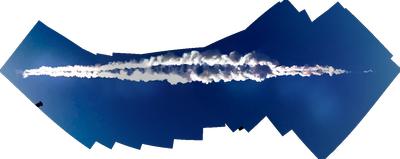 Just after 9am local time on Feb 15, 2013 a bright,
long-lasting fireball was widely observed over the region of Chelyabinsk,
Russia. This event was of such large energy and deep atmospheric penetration
that the shock wave reaching the surface had sufficient overpressure to blow
out windows, doors and cause light structural damage particularly in the region
near the city of Chelyabinsk. Some 1500 people were injured by flying debris
(mainly broken window glass) as a result of the shock wave. In this talk I will
discuss the techniques used to estimate the total energy released by this airburst,
now estimated to be approximately 0.5 Megatons of TNT equivalent.The airwave
from the airburst was recorded over the entire globe; some records show several
revolutions of the planet (including antipodal returns) lasting as much as two
days after the event. The range of energy yields translates into a meteoroid with
a mass of order 10 000 tonnes and diameter of approximately 20m. Close to 500
video recordings of the event have been catalogued to date, including at least 200 direct videos
showing the fireball. This fireball event is the most energetic confirmed airburst
since the Tunguska fireball of 1908. Based on our energy estimate the Earth is hit,
on average, by a similarly energetic object only once every ~75 years.
Just after 9am local time on Feb 15, 2013 a bright,
long-lasting fireball was widely observed over the region of Chelyabinsk,
Russia. This event was of such large energy and deep atmospheric penetration
that the shock wave reaching the surface had sufficient overpressure to blow
out windows, doors and cause light structural damage particularly in the region
near the city of Chelyabinsk. Some 1500 people were injured by flying debris
(mainly broken window glass) as a result of the shock wave. In this talk I will
discuss the techniques used to estimate the total energy released by this airburst,
now estimated to be approximately 0.5 Megatons of TNT equivalent.The airwave
from the airburst was recorded over the entire globe; some records show several
revolutions of the planet (including antipodal returns) lasting as much as two
days after the event. The range of energy yields translates into a meteoroid with
a mass of order 10 000 tonnes and diameter of approximately 20m. Close to 500
video recordings of the event have been catalogued to date, including at least 200 direct videos
showing the fireball. This fireball event is the most energetic confirmed airburst
since the Tunguska fireball of 1908. Based on our energy estimate the Earth is hit,
on average, by a similarly energetic object only once every ~75 years.

